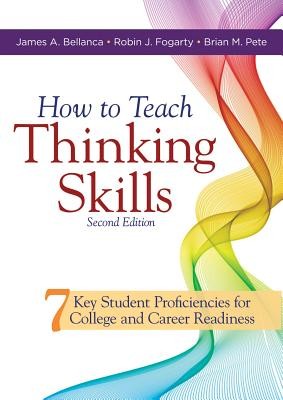
- We will send in 10–14 business days.
- Author: James A Bellanca
- Publisher: SOLUTION TREE
- ISBN-10: 1947604899
- ISBN-13: 9781947604896
- Format: 17.8 x 25.2 x 2 cm, minkšti viršeliai
- Language: English
- SAVE -10% with code: EXTRA
Reviews
Description
Ensure your students develop the complex, higher-order thinking skills they need to not just survive but thrive in a 21st century world. The latest edition of this best-selling guide by James A. Bellanca, Robin J. Fogarty, and Brian M. Pete details a three-phase teaching model and dives deep into how to teach seven key student proficiencies: critical thinking, creative thinking, complex thinking, comprehensive thinking, collaborative thinking, communicative thinking, and cognitive transfer.
How to teach higher-order thinking skills for student engagement and achievement:
- Receive guidance on teaching higher-order thinking skills according to any given standard, including state standards and content-area standards.
- Learn how to weave thinking skills and technology into your existing teaching strategies and lesson plans.
- Understand how to adapt lessons for various grade levels and subjects.
- Gain questions to reflect on after lessons, to ensure that students learn at the highest levels and grow their problem solving and innovative thinking.
- Attain tools and reproducibles to facilitate learning and understanding of teaching critical thinking and other 21st century skills.
Contents:
Acknowledgments
Table of Contents
About the Authors
Introduction
Student Proficiency 1: Critical Thinking
Chapter 1: Analyze
Chapter 2: Evaluate
Chapter 3: Problem Solve
Student Proficiency 2: Creative Thinking
Chapter 4: Generate
Chapter 5: Associate
Chapter 6: Hypothesize
Student Proficiency 3: Complex Thinking
Chapter 7: Clarify
Chapter 8: Interpret
Chapter 9: Determine
Student Proficiency 4: Comprehensive Thinking
Chapter 10: Understand
Chapter 11: Infer
Chapter 12: Compare and Contrast
Student Proficiency 5: Collaborative Thinking
Chapter 13: Explain
Chapter 14: Develop
Chapter 15: Decide
Student Proficiency 6: Communicative Thinking
Chapter 16: Reason
Chapter 17: Connect
Chapter 18: Represent
Student Proficiency 7: Cognitive Transfer
Chapter 19: Synthesize
Chapter 20: Generalize
Chapter 21: Apply
Appendix A
Appendix B
Appendix C
Appendix D
Glossary
References & Resources
Index
EXTRA 10 % discount with code: EXTRA
The promotion ends in 22d.21:19:53
The discount code is valid when purchasing from 10 €. Discounts do not stack.
- Author: James A Bellanca
- Publisher: SOLUTION TREE
- ISBN-10: 1947604899
- ISBN-13: 9781947604896
- Format: 17.8 x 25.2 x 2 cm, minkšti viršeliai
- Language: English English
Ensure your students develop the complex, higher-order thinking skills they need to not just survive but thrive in a 21st century world. The latest edition of this best-selling guide by James A. Bellanca, Robin J. Fogarty, and Brian M. Pete details a three-phase teaching model and dives deep into how to teach seven key student proficiencies: critical thinking, creative thinking, complex thinking, comprehensive thinking, collaborative thinking, communicative thinking, and cognitive transfer.
How to teach higher-order thinking skills for student engagement and achievement:
- Receive guidance on teaching higher-order thinking skills according to any given standard, including state standards and content-area standards.
- Learn how to weave thinking skills and technology into your existing teaching strategies and lesson plans.
- Understand how to adapt lessons for various grade levels and subjects.
- Gain questions to reflect on after lessons, to ensure that students learn at the highest levels and grow their problem solving and innovative thinking.
- Attain tools and reproducibles to facilitate learning and understanding of teaching critical thinking and other 21st century skills.
Contents:
Acknowledgments
Table of Contents
About the Authors
Introduction
Student Proficiency 1: Critical Thinking
Chapter 1: Analyze
Chapter 2: Evaluate
Chapter 3: Problem Solve
Student Proficiency 2: Creative Thinking
Chapter 4: Generate
Chapter 5: Associate
Chapter 6: Hypothesize
Student Proficiency 3: Complex Thinking
Chapter 7: Clarify
Chapter 8: Interpret
Chapter 9: Determine
Student Proficiency 4: Comprehensive Thinking
Chapter 10: Understand
Chapter 11: Infer
Chapter 12: Compare and Contrast
Student Proficiency 5: Collaborative Thinking
Chapter 13: Explain
Chapter 14: Develop
Chapter 15: Decide
Student Proficiency 6: Communicative Thinking
Chapter 16: Reason
Chapter 17: Connect
Chapter 18: Represent
Student Proficiency 7: Cognitive Transfer
Chapter 19: Synthesize
Chapter 20: Generalize
Chapter 21: Apply
Appendix A
Appendix B
Appendix C
Appendix D
Glossary
References & Resources
Index


Reviews